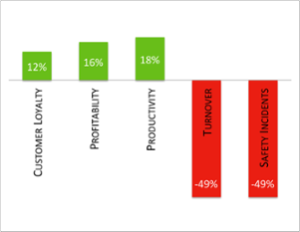Engaging employees is a hot topic of conversation. Last month I explained why engagement is important: companies with engaged employees perform better.
In fact, research has found significant improvement in bottom line measures for organizations with top engagement scores. Just look at the chart below.
But what is engagement, really?
Engagement Defined
Employee engagement is the extent to which employees commit to something or someone in their organization, how hard they work, and how long they stay as a result of that commitment.
 There are two types of commitment: rational (“thinking”) commitment, the extent to which employees believe their managers, teams or organizations have their self-interest in mind, be it financial, developmental, or professional; and emotional (“feeling”) commitment, the extent to which employees value, enjoy and believe in their jobs, managers, teams or organizations.
There are two types of commitment: rational (“thinking”) commitment, the extent to which employees believe their managers, teams or organizations have their self-interest in mind, be it financial, developmental, or professional; and emotional (“feeling”) commitment, the extent to which employees value, enjoy and believe in their jobs, managers, teams or organizations.
The outputs of commitment are normally seen in two ways – either discretionary effort or intent to stay. Discretionary effort is the employee’s motivation and willingness to go above and beyond the call of duty in such actions as helping others with heavy workloads, volunteering for additional duties and looking for ways to perform the job more effectively. Employees who are rationally and emotionally committed display four times the discretionary effort than those who are not. This discretionary effort results in increased productivity and performance. The second output of commitment is intent to stay, which is the employee’s desire to stay with the organization is based on whether they intend to look for a new job within a year, whether they are frequently thinking of quitting, whether they are actively looking for a job, or have begun to take tangible steps to seek alternate employment outside of the organization. An employee’s intent to stay directly impacts retention within an organization.
How can YOU impact engagement?
A great starting point as a leader is to ask yourself these questions:
- How engaged am I – what would my team say about my energy, commitment and drive towards the company’s goals?
- Why should my team’s engagement matter to me?
- What changes can I make in my everyday behaviour to improve my team’s engagement?
- How engaged is my team?
- Are there segments within the organization that are more or less engaged?
- Is my team more or less engaged than that of my competitors?
- How can I best drive employee engagement to higher levels?
Have you had success engaging your workforce? Share your successes (or troubles) in the comments below.
Happy Engaging!
Linda A. Barlow, CHRP
Global HR Thought Leader

